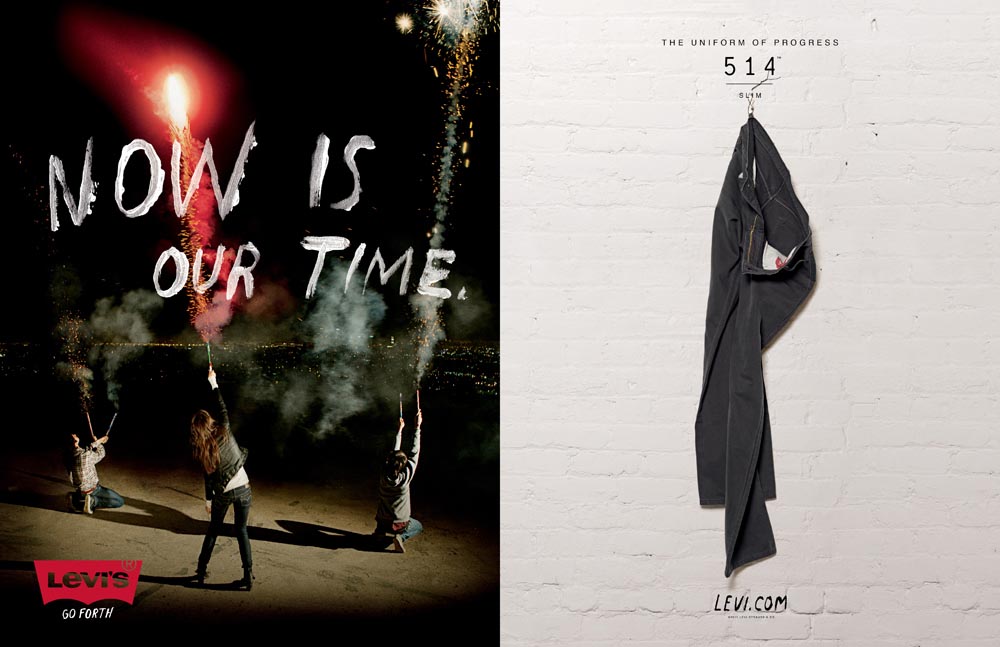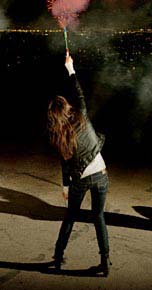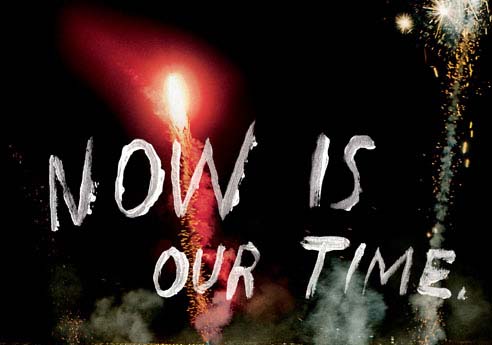

| The left side reveals a clear Ideal and Real. The Ideal is the most salient aspect of the image, as well as something that is presented as idealized (Kress and Van Leeuwen 187). Here, the Ideal is the image of the youths and their fireworks, as well as the tagline "NOW IS OUR TIME." Correspondingly, the Real or the practical information is the Levi's logo at the bottom of the page (Kress and Van Leeuwen 187). The meaning of this separation is that the advertisement assumes its audience to value the act of setting off fireworks and what it represents, as well as having it be "our time." Before continuing further, it is vital to consider what the connotative meaning of fireworks really is. First of all, fireworks are explosive, familial, and celebratory, but they are also dangerous. Sometimes they are used by hoodlums to stir up ruckus. The subjects do not appear like a family celebrating the New Year, so it is safe to posit that these fireworks represent more the celebration of danger. Like in the commercial, this danger is associated with freedom and individuality. The youths in this photo are not at a fireworks festival. They are alone on a hill at night. They are breaking away from the crowd to do something that they value. It is their time to celebrate who they are authentically. Another consideration of the Ideal is the inherent exhibitionism in the act of setting off fireworks. These youths are exhibitionist in the celebration of their time, none more so than the female standing in the middle. She is positioned above her male friends and the eye naturally goes to her as her firework is brighter, she is standing, and she is in the center of the bottom half. She is the true ideal because she is what the male viewer of this advertisement desires to have. As Mulvey says, "[women are] the bearer of meaning, not maker of meaning" (Mulvey 394). In her exhibitionism, she is a desired image and we see her with the male gaze. Because of her lack of contact and subsequent offer, we are positioned to castrate her. She cannot be really free because she is objectified by the active male visuality. She could be interpreted as a powerful figure of agency, but instead the male gaze objectifies her through the power of scopophilic viewing. | 
|
 | When viewing the advertisement as a whole, there is a clear distinction between the Given and the New. The previously discussed left side is the Given, or something "that is presented as something the viewer already knows" (Kress and Van Leeuwen 181). In this case, the scene of setting off fireworks is presented as something that the viewer already wants. The tagline directly interpellates the viewer and includes him/her in the same category as the subjects in the image. They are all ready for "our time." This placements values "our time" as something that everyone wants and needs to be in. Because of this valuation, the viewer feels a lack that he/she did not know that they had. He/she has unknowingly been living in someone else's time, not in his/her own individualistic era of authenticity and freedom. He/she feels this lack and searches for a solution, which is located on the right side. The right side is the New which holds new or not yet accepted information (Kress and Van Leeuwen 181). Here the advertisement pictures a pair of Levi's, calling them "the uniform of progress." In this way, the Given and the New create a problem and then resolves it for the viewer through consumerism. This print advertisement from the Go Forth campaign works to reinforce the overall messages of the campaign. Because print is substantially more limited in resources than commercials, the advertisement is more blatant in its use of pecuniary distortion of values. Nonetheless, it uses the values of freedom, individualism, and authenticity to get audiences to adhere to a traditional consumer lifestyle. |
Kress, Gunther R, and Leeuwen T. Van. Reading Images: The Grammar of Visual Design. London: Routledge, 2006. Print.
Levi's. Wieden + Kennedy. N.p., n.d. Web. 20 Apr. 2014. Link
Mulvey, Laura. "Visual Pleasure and Narrative Cinema." In Media & Cultural Studies: Keyworks, edited by Meenakshi Gigi Durham and Douglas M. Kellner, 393-404. Malden, MA: Blackwell, 2001. Print.